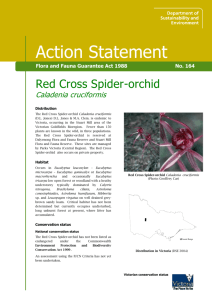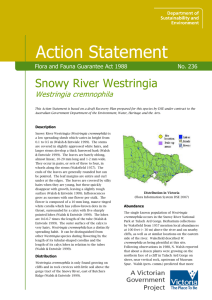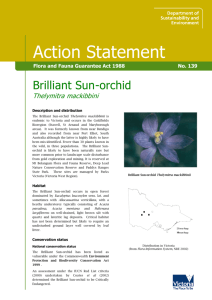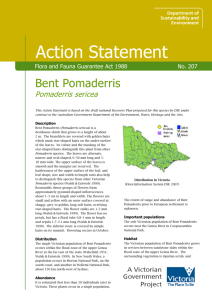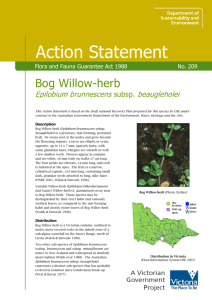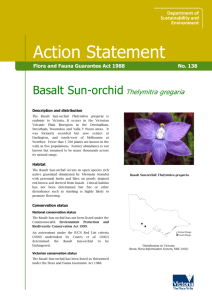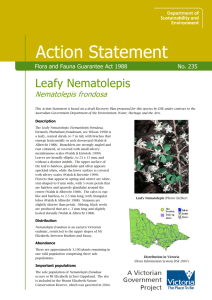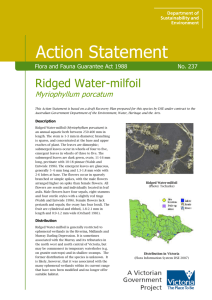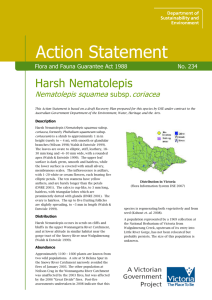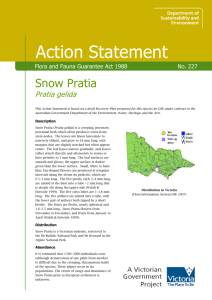Conservation status - Department of Environment, Land, Water and
advertisement
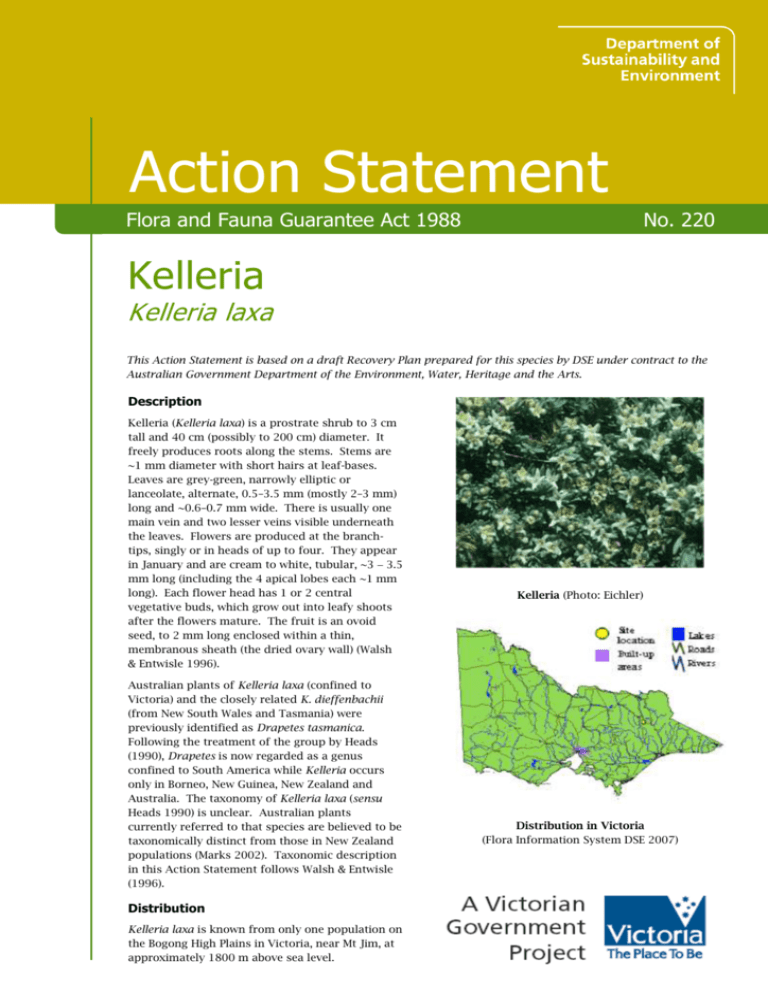
Action Statement Flora and Fauna Guarantee Act 1988 No. 220 Kelleria Kelleria laxa This Action Statement is based on a draft Recovery Plan prepared for this species by DSE under contract to the Australian Government Department of the Environment, Water, Heritage and the Arts. Description Kelleria (Kelleria laxa) is a prostrate shrub to 3 cm tall and 40 cm (possibly to 200 cm) diameter. It freely produces roots along the stems. Stems are ~1 mm diameter with short hairs at leaf-bases. Leaves are grey-green, narrowly elliptic or lanceolate, alternate, 0.5–3.5 mm (mostly 2–3 mm) long and ~0.6–0.7 mm wide. There is usually one main vein and two lesser veins visible underneath the leaves. Flowers are produced at the branchtips, singly or in heads of up to four. They appear in January and are cream to white, tubular, ~3 3.5 mm long (including the 4 apical lobes each ~1 mm long). Each flower head has 1 or 2 central vegetative buds, which grow out into leafy shoots after the flowers mature. The fruit is an ovoid seed, to 2 mm long enclosed within a thin, membranous sheath (the dried ovary wall) (Walsh & Entwisle 1996). Australian plants of Kelleria laxa (confined to Victoria) and the closely related K. dieffenbachii (from New South Wales and Tasmania) were previously identified as Drapetes tasmanica. Following the treatment of the group by Heads (1990), Drapetes is now regarded as a genus confined to South America while Kelleria occurs only in Borneo, New Guinea, New Zealand and Australia. The taxonomy of Kelleria laxa (sensu Heads 1990) is unclear. Australian plants currently referred to that species are believed to be taxonomically distinct from those in New Zealand populations (Marks 2002). Taxonomic description in this Action Statement follows Walsh & Entwisle (1996). Distribution Kelleria laxa is known from only one population on the Bogong High Plains in Victoria, near Mt Jim, at approximately 1800 m above sea level. Kelleria (Photo: Eichler) Distribution in Victoria (Flora Information System DSE 2007) Habitat The single population of Kelleria laxa (comprising 19 ‘patches’ or subpopulations) occurs in Bog Snow-grass (Poa costiniana) grassland and Mud Pratia (Lobelia surrepens) – Alpine Stackhousia (Stackhousia pulvinaris) herbland. The topography is more-or-less flat or falling slightly to the north, south and east. Plants occur on alpine humus soils, typically ~40 cm deep, derived from basalt parent material and organic matter. Plants tend to occur in slightly depressed sites. It is suspected that semi-saturated soils are important for plant survival, and there is anecdotal evidence of decline on drier sites between 1993 and 2002 (N. Walsh pers obs.). Abundance It is considered ‘endangered’ in Victoria according to DSE’s Advisory List of Rare or Threatened Plants in Victoria – 2005 (DSE 2005). Potentially threatening processes Drought Drying of site during periods of drought appears to lead to declines in abundance (N. Walsh pers obs.). Recreational Damage Recreational walkers may damage patches on or close to the Alpine Walking Track. Grazing Grazing and trampling by feral horses threatens all patches. It is estimated that approximately 1700 individuals exist, although it is very difficult to be sure of the boundaries of individual plants. These plants occur in 19 patches within a single population. The extent of range and abundance of Kelleria laxa prior to European settlement is unknown. Inappropriate biomass reduction / fire regimes Important populations Greenhouse Effect The sole population of Kelleria laxa occurs in the Alpine National Park at Mt Jim. Temperature increases predicted due to global warming may further reduce suitable habitat for Kelleria laxa. Loss of climatic habitat caused by anthropogenic emissions of greenhouse gases is listed as a key threatening process under the Environment Protection and Biodiversity Conservation Act 1999. Life history and ecology There have been no targeted studies of the ecology of Kelleria laxa but some aspects of the species’ ecology were addressed in an Honours study (Marks 2002). Conservation status National conservation status Kelleria is listed as ‘vulnerable’ under the Commonwealth Environment Protection and Biodiversity Conservation Act 1999. Victorian conservation status All known patches of Kelleria appear unaffected by the January 2003 Alpine National Park fires (J. Morgan pers. comm.). However, fires in the future may damage populations and recovery is likely to be hampered if grazing threats remain. Previous management action Post-fire assessment and monitoring of priority populations of threatened flora after the 2003 wildfire in the Victorian Alps has been conducted. This included mapping of populations in conjunction with fire boundary using existing information, site visits, and data collection describing habitat condition, threats, population demography and vital attributes. Kelleria is listed as ‘threatened’ under the Victorian Flora and Fauna Guarantee Act 1988. Conservation objectives, actions and targets Long term objective To ensure that the Kelleria can survive, flourish and retain its potential for evolutionary development in the wild. Specific objectives, actions and targets The intended management actions listed below are further elaborated in DSE’s Actions for Biodiversity Conservation (ABC) system. Detailed information about the actions and locations, including priorities, is held in this system and will be provided annually to land managers and other authorities. 2 Objective I To increase knowledge of biology, ecology and management requirements Action Targets Responsible 1. Clarify/review taxonomy. Clarify taxonomy to enable an accurate conservation status assessment. Taxonomic revision of Kelleria laxa. Royal Botanic Gardens Acquire baseline population data by conducting detailed field and desk top surveys including identification of the area and extent of the population; estimates of the number, size and structure of the population; and inference or estimation of population change. Updated records on all state databases (FIS, VROTPop and Herbarium). Assess habitat characteristics and/or condition. Accurately survey known habitat, and collect floristic and environmental information relevant to community ecology and condition. Ecological requirements identified for the completion of essential life history stages, recruitment and dispersal. 4. Conduct survey to locate suitable habitat. Identify and survey potential habitat using ecological and bioclimatic information that may indicate habitat preference. Predictive model for potential habitat developed and tested. DSE 5. Undertake research to identify key biological functions. Evaluate current reproductive / regenerative status, seed bank status and longevity, fecundity, and recruitment levels. Determine seed germination requirements by conducting laboratory and field trials aimed to identify key stimuli, and determine stimuli for vegetative regeneration. Seed bank/regenerative potential quantified for target populations. DSE Royal Botanic Gardens 2. 3. Determination or update of conservation status for inclusion on state and national threatened species lists. DSE Populations accurately mapped. DSE Core habitat mapped. Stimuli for recruitment/regeneration identified. Management strategies identified to maintain, enhance or restore regenerative processes fundamental to reproduction and survival. Determine recruitment response to the January 2003 fires in burnt patches, if they are located. 6. Analyse population trends. Measure population trends and responses against recovery actions by collecting demographic information including recruitment and mortality, timing of life history stages and morphological data. Collate, analyse and report on census data and compare with management histories. Objective II Techniques for monitoring developed and implemented. DSE Census data for target populations. Population growth rates determined. Population Viability Analysis completed for targeted populations. To secure populations or habitat from potentially incompatible land use or catastrophic loss. Action Targets Responsible 7. Development of effective propagation and cultivation techniques. DSE, Royal Botanic Gardens Establish cultivated plants ex situ to safeguard from the unforeseen destruction of the wild population. At least 30 mature plants in cultivation. 3 Objective III To maintain or enhance habitat for Kelleria. Action Targets Responsible 8. Periodic threat monitoring completed. Parks Victoria Assess threats. Periodically monitor the threat posed by browsing and weed invasion. Objective IV Management action planned where required. To increase the number of populations or individuals Action Targets Responsible 9. Long-term storage facility identified. DSE, Royal Botanic Gardens Store reproductive material. Establish a seed bank. 10. Determine seed viability. Objective V Seed from important populations in storage. Seed viability determined. Royal Botanic Gardens To increase community awareness and support Action Targets Responsible 11. Involve community groups and volunteers in recovery activities. Opportunities for involvement identified, promoted and supported. DSE References DSE (2005) Advisory List of Rare or Threatened Plants in Victoria – 2005. Department of Sustainability and Environment, East Melbourne, Victoria. Heads, M.J. (1990) Kelleria, in: Flora of Australia Volume 18: Podostemaceae to Combretaceae, George, A.S. (ed), Australian Government Publishing Service, Canberra. Marks, C. 2002. Investigations into Kelleria laxa and Kelleria dieffenbachii. Honours thesis, School of Botany, University of Melbourne. Walsh, N.G. & Entwisle, T.J. (1996) Flora of Victoria, Vol 3: Dicotyledons: Winteraceae to Myrtaceae, Inkata Press, Melbourne. This Action Statement has been prepared under section 19 of the Flora and Fauna Guarantee Act 1988 under delegation from Mr Peter Harris, Secretary, Department of Sustainability and Environment, July 2008. Published by the Victorian Government Department of Sustainability and Environment Melbourne, July 2009 © The State of Victoria Department of Sustainability and Environment 2009 This publication is copyright. No part may be reproduced by any process except in accordance with the provisions of the Copyright Act 1968. Authorised by the Victorian Government, 8 Nicholson Street, East Melbourne. ISSN 1448-9902 For more information contact the DSE Customer Service Centre 136 186 Disclaimer This publication may be of assistance to you but the State of Victoria and its employees do not guarantee that the publication is without flaw of any kind or is wholly appropriate for your particular purposes and therefore disclaims all liability for any error, loss or other consequence which may arise from you relying on any information in this publication. Accessibility If you would like to receive this publication in an accessible format, such as large print or audio, please telephone 136 186, 1800 122 969 (TTY), or email customer.service@dse.vic.gov.au This document is also available in PDF format on the Internet at www.dse.vic.gov.au 4
